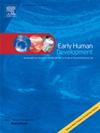心率对稳定和患病早产儿收缩期和舒张期时间间隔及心功能的影响
IF 2.2
3区 医学
Q2 OBSTETRICS & GYNECOLOGY
引用次数: 0
摘要
舒张功能包括心脏的舒张和充盈,取决于心率(HR)和收缩期(St)或舒张期(Dt)的时间。St/Dt比值随着HR的增加而增加,是心力衰竭患儿整体心功能的标志。本研究的目的是描述早产儿的心脏周期事件。方法回顾性分析32周早产儿的心脏超声心动图,从组织多普勒图像中寻找心脏周期事件,并根据扫描的临床指征分为稳定或临床恶化伴重大疾病。结果分析了201例早产儿的412次扫描结果。St/Dt比值随HR的增加而增加。St从心脏周期长度的50%增加到54%,舒张期缩短。在心脏周期的9%和12%时,等容量收缩和舒张保持不变。平均St、Dt和St/Dt比值分别为195(19)msec、175(24)msec和1.13 (0.16)msec。未服用心血管药物的患儿St明显缩短,St/Dt比值明显降低。心血管药物增加等容时间、Dt和早期舒张持续时间。结论心脏周期持续时间和St/Dt比值有一定的参考值。早产儿心脏通过优化其力频率关系和增强舒张,向收缩期转移和缩短早期舒张期,以适应更高的心率。St/Dt比值在有重大疾病的早产儿中发生改变。这种简单的超声标记可以在进一步研究早产儿心血管药物的研究中进行测试本文章由计算机程序翻译,如有差异,请以英文原文为准。
The effect of heart rate on systolic and diastolic time intervals and cardiac function in stable and sick preterm infants
Background
Diastolic function includes relaxation and filling of the heart and is dependent on heart rate (HR) and time spent in either systole (St) or diastole (Dt). The St/Dt ratio increases as HR increased and is a marker of overall cardiac function in children with heart failure. The aim of this study is to describe cardiac cycle events in preterm infants.
Methods
Cardiac ultrasounds of preterm infants <32 weeks were retrospectively reviewed for cardiac cycle events from Tissue Doppler images and grouped by clinical indication of the scan as stable or as clinical deterioration with significant illness.
Results
412 scans in 201 preterm infants were analyzed. St/Dt ratio increased with increasing HR. St increased from 50 to 54 % of the cardiac cycle length with shortened diastolic duration. Isovolumetric contraction and relaxation remained unchanged at 9 and 12 % of the cardiac cycle respectively. Mean St, Dt and St/Dt ratio in stable infants were 195(19) msec, Dt 175(24) msec and 1.13 (0.16) respectively. Sick infants without cardiovascular medications showed a significantly shorter St and lower St/Dt ratio. Cardiovascular medications increased isovolumetric times, Dt, and early diastolic duration.
Conclusion
Reference values for cardiac cycle durations and St/Dt ratio are presented. Preterm hearts adapt to higher HR by shifting towards systole and shortened early diastole by optimising its force frequency relationship and enhanced relaxation. The St/Dt ratio was altered in preterm infants with significant illness. This simple ultrasound marker could be tested in further studies that investigate cardiovascular medications in preterm infants
求助全文
通过发布文献求助,成功后即可免费获取论文全文。
去求助
来源期刊

Early human development
医学-妇产科学
CiteScore
4.40
自引率
4.00%
发文量
100
审稿时长
46 days
期刊介绍:
Established as an authoritative, highly cited voice on early human development, Early Human Development provides a unique opportunity for researchers and clinicians to bridge the communication gap between disciplines. Creating a forum for the productive exchange of ideas concerning early human growth and development, the journal publishes original research and clinical papers with particular emphasis on the continuum between fetal life and the perinatal period; aspects of postnatal growth influenced by early events; and the safeguarding of the quality of human survival.
The first comprehensive and interdisciplinary journal in this area of growing importance, Early Human Development offers pertinent contributions to the following subject areas:
Fetology; perinatology; pediatrics; growth and development; obstetrics; reproduction and fertility; epidemiology; behavioural sciences; nutrition and metabolism; teratology; neurology; brain biology; developmental psychology and screening.
 求助内容:
求助内容: 应助结果提醒方式:
应助结果提醒方式:


